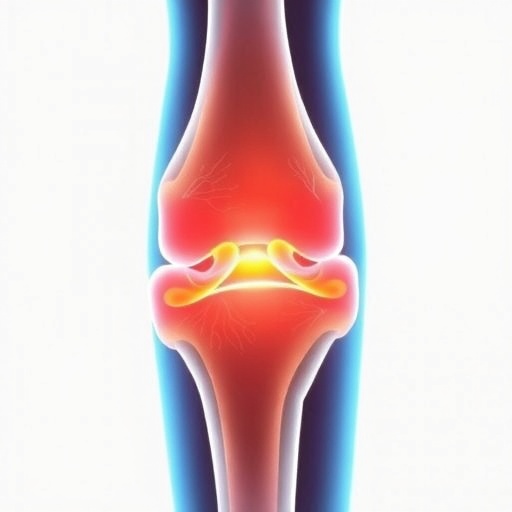In a groundbreaking study set to reshape our understanding of osteoarthritis (OA) treatment, researchers have unveiled the intricate mechanisms by which astragaloside, a bioactive compound derived from traditional herbal sources, exerts a therapeutic effect on OA. This degenerative joint disease, marked by cartilage deterioration, osteophyte formation, and synovial inflammation, has long challenged medical science due to limited effective treatments and significant side effects associated with conventional therapies. The new research leverages advanced network pharmacology, molecular docking, and animal models to decode the multifaceted biological interactions of astragaloside in combating this chronic condition.
Osteoarthritis remains a leading cause of disability worldwide, with current Western medical interventions often involving surgery or pharmacological approaches that only partially alleviate symptoms while bearing risks of adverse effects. The advent of network pharmacology, which combines systems biology and computational technology, offers a novel avenue to map complex biological networks and predict drug-target interactions at a systemic level. By applying these techniques, the research team sought to identify the molecular targets of astragaloside relevant to OA pathology, thereby illuminating the compound’s multifactorial mechanism of action.
The study commenced with comprehensive database mining to collate potential targets associated with both astragaloside and OA. The intersection of these target gene sets was then employed to construct a protein-protein interaction (PPI) network, laying the foundation for subsequent analyses. This approach enabled the identification of core subnetworks and the top 10 pivotal genes implicated in the therapeutic effects of astragaloside, offering a focused framework to understand how this compound modulates disease pathways at the molecular level.
Subsequent gene ontology (GO) and Kyoto Encyclopedia of Genes and Genomes (KEGG) enrichment analyses further delineated the biological processes and signaling pathways influenced by astragaloside treatment. The GO analysis revealed an extensive array of annotation items, underscoring the diverse functional roles of the target genes, particularly in processes related to endothelial permeability, synovial function, chondrocyte survival, proliferation, and extracellular matrix synthesis. Meanwhile, KEGG pathway mapping highlighted key signaling cascades, including the Src/PI3K/Akt, NF-κB, MAPK, and Toll-like receptor (TLR) pathways, all of which contribute to inflammatory regulation and cellular homeostasis in osteoarthritis.
Molecular docking simulations provided compelling evidence of the binding affinity between astragaloside and critical target proteins, affirming the predicted interactions generated through network pharmacology. These simulations enhance the understanding of molecular conformations and binding energetics, offering clues about how astragaloside could inhibit or modulate signaling proteins to ameliorate pathological changes characteristic of OA.
To translate these bioinformatic findings into physiological relevance, the researchers conducted in vivo experiments on OA-induced rabbits. They administered astragaloside intra-articularly, comparing outcomes with a control group receiving saline. Over a four-week period, the therapeutic benefits of astragaloside became evident, as histological staining and magnetic resonance imaging (MRI) showed marked reductions in knee joint fluid accumulation and bone marrow lesions, hallmarks of OA progression.
Moreover, quantitative real-time PCR analysis revealed nuanced gene expression changes in response to astragaloside treatment. Notably, the expression levels of SRC and TLR4 were significantly upregulated, suggesting an activation of signaling pathways that promote tissue repair and immunomodulation. Conversely, genes such as ALB and ESR1 were downregulated, reflecting potential suppression of inflammatory or degenerative processes. These molecular signatures provide a deeper insight into the gene regulatory networks modulated by astragaloside during OA therapy.
The multi-target and multi-pathway paradigm uncovered by this study underscores the sophistication of astragaloside’s therapeutic profile. Unlike single-target drugs, astragaloside appears to engage a constellation of molecular actors, orchestrating a balanced modulation of cellular activities that culminate in cartilage protection, synovial regulation, and attenuation of inflammatory responses within the joint microenvironment.
Importantly, this work highlights the Src/PI3K/Akt signaling axis as a central conduit through which astragaloside exerts its effects. This pathway, known for regulating cell survival, proliferation, and metabolism, is implicated in chondrocyte function and joint tissue homeostasis. By modulating Src kinase activity and downstream PI3K/Akt signaling, astragaloside may foster a cellular milieu conducive to cartilage regeneration and inhibition of apoptotic pathways that exacerbate OA damage.
Parallel involvement of the NF-κB and MAPK pathways further elucidates the anti-inflammatory properties of astragaloside. These signaling cascades are pivotal in mediating immune responses and inflammatory cytokine production. By attenuating activation within these pathways, astragaloside likely curbs the chronic inflammatory milieu that drives joint degradation in OA sufferers.
The engagement of Toll-like receptor pathways represents an additional layer of immune regulation influenced by astragaloside. Toll-like receptors serve as sentinels of innate immunity, detecting endogenous and exogenous danger signals. Modulating TLR4 expression and downstream signaling may recalibrate immune responses in the osteoarthritic joint, reducing synovial inflammation and fostering repair processes.
Collectively, this integrative study elucidates a compelling mechanistic narrative for astragaloside’s efficacy against osteoarthritis, bridging computational predictions and empirical validation. The findings pave the way for developing novel therapeutic strategies that harness the compound’s multitarget capabilities, potentially offering safer and more effective alternatives to current OA interventions.
As the global burden of osteoarthritis continues to rise with aging populations, the implications of this research resonate beyond academic circles. Incorporating natural compounds like astragaloside into clinical practice could revolutionize OA management, emphasizing precision medicine approaches grounded in molecular insight and systemic network modulation. Future clinical trials will be essential to confirm these promising preclinical results and to optimize dosing regimens for maximal therapeutic benefit.
In summary, the study spearheaded by Song and colleagues not only advances our understanding of astragaloside’s multifaceted biological actions in osteoarthritis treatment but also exemplifies the power of network pharmacology in drug discovery. This synergistic combination of computational and experimental frameworks may herald a new era of integrative medicine, transforming how complex diseases like OA are approached and managed.
Subject of Research: Osteoarthritis treatment mechanisms using astragaloside through network pharmacology and molecular docking combined with animal experiments.
Article Title: Exploring the mechanism of action of astragaloside in the treatment of osteoarthritis based on network pharmacology.
Article References:
Song, D., Li, J., Sun, Y. et al. Exploring the mechanism of action of astragaloside in the treatment of osteoarthritis based on network pharmacology. BioMed Eng OnLine 24, 119 (2025). https://doi.org/10.1186/s12938-025-01445-x
Image Credits: AI Generated




